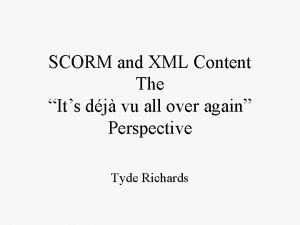A Holy Grail of Machine Learing Outputs Just







- Slides: 7

A “Holy Grail” of Machine Learing Outputs Just a Data Set or just an explanation of the problem Automated Learner Hypothesis Input Features

Ensembles • Multiple diverse models (Inductive Biases) are trained on the same problem and then their outputs are combined • The specific overfit of each learning model is averaged out • If models are diverse (uncorrelated errors) then even if the individual models are weak generalizers, the ensemble can be very accurate • Many different Ensemble approaches – Stacking, Gating/Mixture of Experts, Bagging, Boosting, Wagging, Mimicking, Combinations Combining Technique M 1 M 2 M 3 Mn

Bias vs. Variance • Multiple trained models can average out the variance • Leaving just the Bias • Weak learners?

Bagging • Bootstrap aggregating (Bagging) • Each TS chosen uniformly at random with replacement from the original data set • All hypotheses have an equal vote • Bagging mostly focused on getting rid of variance • Consistent strong empirical improvement • Does not overfit (whereas boosting may), but may be more conservative overall on accuracy improvements • Often used with the same learning algorithms and thus best for those which tend to give more diverse hypotheses based on initial random conditions

Boosting • Many variations • Boosting more aggressive on accuracy but in some cases could overfit and do worse – can theoretically converge to training set – similar to a constructive neural network (DMP) • Boosting by resampling - (Each TS chosen randomly with distribution Di with replacement from the original data set. Typically the same size as the original data set. ) • Some learning algorithms can handle the weighted samples directly • Potential to overfit, but empirically quite good

Ensemble Creation Approaches • Goal is to get less correlated errors • Injecting randomness – initial weights, different learning parameters, etc. • Different Training sets – Bagging, Boosting, different features, etc. • Forcing differences – different objective functions, auxiliary tasks • Different machine learning models

Ensemble Combining Approaches • Stacking • Unweighted Voting • Weighted voting – learned (single layer), based on accuracy, training set, • Gating function – The gating function uses the input features to decide which combination (weights) of expert voting to use













